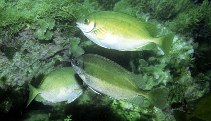| Family: |
Siganidae (Rabbitfishes) |
| Max. size: |
30 cm TL (male/unsexed) |
| Environment: |
reef-associated; marine; depth range 2 - 40 m |
| Distribution: |
Western Indian Ocean: Persian Gulf (Ref.80050); Red Sea and East Africa to islands in the western Indian Ocean. Immigrant to Mediterranean via the Suez Canal. |
| Diagnosis: |
Dorsal spines (total): 13-14; Dorsal soft rays (total): 10-10; Anal spines: 7-7; Anal soft rays: 9-9; Vertebrae: 13-13. Regional variation in color exists. Anterior spines of median fins slender and pungent, posterior spines stout, all venomous including that on the nape. Preopercular angle 87-97 degrees. Anterior nostril with a long, broad flap covering posterior nostril when depressed. Variable cheek scalation. Midline of thorax devoid of scales between the pelvic ridges. |
| Biology: |
Found in small schools in very shallow water close to the bottom. Prefer hard bottoms of compacted sand with rock or coral debris. Solitary adults and groups of 3 or 4 adults have also been observed. Feed on a wide range of benthic algae. May suddenly stop and erect its fins (dorsal, anal and pelvic) presenting an encircling array of spines to potential predators; these spines are venomous. A food fish that is occasionally poisonous (Ref. 4537). Probably does not adapt well in captivity (Ref. 12382). A thermophilic species (Ref. 120766). Minimum depth from Ref. 9710. |
| IUCN Red List Status: |
Least Concern (LC); Date assessed: 19 July 2017 Ref. (130435)
|
| Threat to humans: |
venomous |
Source and more info: www.fishbase.org. For personal, classroom, and other internal use only. Not for publication.

